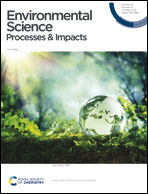Phthalate migration and its effects on poly(vinyl chloride)-based footwear: pathways, influence of environmental conditions, and the possibility of human exposure†
Abstract
The study of phthalate migration in footwear is important from an environmental viewpoint and the consumer health perspective as it remains in direct contact with the user for a long time. In this research article, the migration of phthalate, specifically di-(2-ethylhexyl) phthalate (DEHP), from the poly(vinyl chloride) (PVC) shoe sole to the attached leather insole has been studied for six months under different environmental conditions. After one month, the DEHP concentration in the PVC sole decreased by 45–58%, and that in the leather insole increased from 0.35 mg g−1 to 38–58 mg g−1. After six months, about 90% of the DEHP has been lost from the PVC sole, and that in the leather insole reached close to its initial value (value before the experiment). The migration rate depends on the environmental conditions and the presence of phthalate soluble solvents in the sole-adhesive-insole system of the footwear. The influence of DEHP migration on the physicochemical characteristics of the PVC sole and leather insole has been studied by Fourier transform infrared spectroscopy-attenuated total reflectance (FTIR-ATR), thermo-gravimetric analysis (TGA), and differential scanning calorimetry (DSC). The migration and emission pathways of DEHP, the influence of environmental conditions, and the possibility of human exposure to phthalate through footwear are discussed.

- This article is part of the themed collection: Environmental exposure and impacts


 Please wait while we load your content...
Please wait while we load your content...